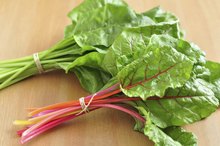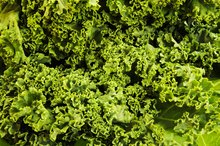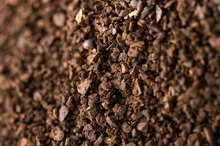Effects of Eating Too Few Vegetables
Your diet has a direct impact on how well your body functions. What you eat helps provide the nutrients that your body cannot manufacture on its own or those it does not store. Vegetables supply essential nutrients that affect a major portion of life processes from the most basic like metabolism to more sophisticated functions such as oxygen transport or breakdown of specific types of nutrients. The “Dietary Guidelines for Americans, 2010” recommends that you eat 2 1/2 cups of vegetables daily.
Gastrointestinal Discomfort
You may suffer gastrointestinal distress first from lack of fiber due to low vegetable intake. Vegetables provide roughage necessary for healthy digestion. A lack of vegetables may result in either constipation or diarrhea, leaving you feeling uncomfortable and unwilling to eat. Vegetables also provide nutrients necessary for metabolism of the foods you eat. The lack of vegetables in your diet can lead to a host of symptoms that may worsen your indigestion.
- You may suffer gastrointestinal distress first from lack of fiber due to low vegetable intake.
- A lack of vegetables may result in either constipation or diarrhea, leaving you feeling uncomfortable and unwilling to eat.
Abnormal Bleeding
Can Certain Vegetables Increase Your White Blood Cells?
Learn More
Green, leafy vegetables like Swiss chard and kale provide healthy doses of vitamin K. This nutrient is essential for proper blood clotting, bone mineralization and cell growth. A deficiency may result in abnormal bleeding due to a reduction in the clotting factors that vitamin K helps produce. Symptoms may include heavy menstrual bleeding, gums bleeding and easy bruising. The body does produce some vitamin K on its own in the intestines, but dietary intake is necessary to ensure that you have adequate amounts.
- Green, leafy vegetables like Swiss chard and kale provide healthy doses of vitamin K. This nutrient is essential for proper blood clotting, bone mineralization and cell growth.
- A deficiency may result in abnormal bleeding due to a reduction in the clotting factors that vitamin K helps produce.
Scurvy
A diet deficient in vegetables may lead to scurvy. While you may associate vitamin C with fruits, vegetables also provide rich sources. Just 1/2 cup serving of sweet red pepper provides more vitamin C than a 6 oz. glass of orange juice. Symptoms of scurvy can lead to joint pain and weakness. The reason behind these effects lies in the role vitamin C plays in the development of connective tissue and bone. Since vitamin C is a water-soluble vitamin, you need to consume adequate amounts daily for good health because the body doesn't store it nor manufacture it.
- A diet deficient in vegetables may lead to scurvy.
- Since vitamin C is a water-soluble vitamin, you need to consume adequate amounts daily for good health because the body doesn't store it nor manufacture it.
Anemia
Does Eating Only Vegetables Every Day Make You Lose Weight?
Learn More
Your avoidance of vegetables may also lead to a folic acid deficiency. Symptoms are not noticeable for several months of inadequate intake, resulting in a type of anemia called megaloblastic anemia. This condition will result in enlarged red blood cells because of folic acid's role in red blood cell formation. A person with megaloblastic anemia may suffer fatigue and shortness of breath because of the role of red blood cells in oxygen transport. Like vitamin C, folic acid is water soluble, meaning that your daily diet must include adequate intake for good health.
- Your avoidance of vegetables may also lead to a folic acid deficiency.
- A person with megaloblastic anemia may suffer fatigue and shortness of breath because of the role of red blood cells in oxygen transport.
Related Articles
References
- Mayo Clinic; Dietary fiber: Essential for a Healthy Diet; November 19, 2009
- Linus Pauling Institute; Vitamin K; Jane Higdon; May 2004
- DermNet NZ; Scurvy; April 5, 2010
- Linus Pauling Institute; Folic Acid; Jane Higdon; April 2002
- Callus CA, Vella S, Ferry P. Scurvy is Back. Nutr Metab Insights. 2018;11:1178638818809097. doi:10.1177/1178638818809097
- National Center for Advancing Translational Sciences. Scurvy. Updated November 14, 2016.
- Bouaziz W, Rebai MA, Rekik MA, Krid N, Ellouz Z, Keskes H. Scurvy: When it is a Forgotten Illness the Surgery Makes the Diagnosis. Open Orthop J. 2017;11:1314-1320. doi:10.2174/1874325001711011314
- Brambilla A, Pizza C, Lasagni D, Lachina L, Resti M, Trapani S. Pediatric Scurvy: When Contemporary Eating Habits Bring Back the Past. Front Pediatr. 2018;6:126. doi:10.3389/fped.2018.00126
- Khalife R, Grieco A, Khamisa K, Tinmouh A, Mccudden C, Saidenberg E. Scurvy, an old story in a new time: The hematologist's experience. Blood Cells Mol Dis. 2019;76:40-44. doi:10.1016/j.bcmd.2019.01.004
- Wijkmans RAA, Talsma K. Modern scurvy. J Surg Case Rep. 2016;2016(1):rjv168. doi:10.1093/jscr/rjv168
- Hansen EPK, Metzsche C, Henningsend E, Toft P. Severe Scurvy After Gastric Bypass Surgery and a Poor Postoperative Diet. J Clin Med Res. 2012;4(2):135-37. doi:10.4021/jocmr726w
- Perry ME, Page N, Manthey DE, Zavitz JM. Scurvy: Dietary Discretion in a Developed Country. Clin Pract Cases Emerg Med. 2018;2(2):147-150. doi:10.5811/cpcem.2018.1.36860
- National Institutes of Health, Office of Dietary Supplements. Vitamin C Fact Sheet for Health Professionals. Updated February 27, 2020.
- Institute of Medicine (US) Panel on Dietary Antioxidants and Related Compounds. Dietary Reference Intakes for Vitamin C, Vitamin E, Selenium, and Carotenoids. Washington, DC: The National Academies Press; 2000.
Resources
Writer Bio
Chris Dinesen Rogers has been online marketing for more than eight years. She has grown her own art business through SEO and social media and is a consultant specializing in SEO and website development. Her past work experience includes teaching pre-nursing students beginning biology, human anatomy and physiology. Rogers's more than 10 years in conservation makes her equally at home in the outdoors.









